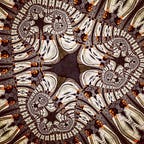Testing DALLE-3 with the 5DIC Image Creativity Benchmark [Syncronicity test case]
In the ever-evolving field of artificial intelligence, image generation models have made significant strides in recent years. Among the most advanced in this domain is OpenAI’s DALL·E-3, an advanced generative model capable of creating images from text descriptions. To evaluate DALL·E-3’s prowess in image creativity, let us define 5DIC as the 5D Image Creativity Benchmark, a five-dimensional evaluation system that assesses image generators on their ability to represent text without errors, create logos, generate infographics, conceptual representations, and mindmaps about a given concept. In this article, we explore how DALL·E-3 performs when subjected to the rigorous standards of the 5DIC benchmark that are not as scientifically established and objective as other benchmarks focused on CLIPS text to image and image to text evaluation (ref. https://arxiv.org/pdf/2307.00716)
- Representing Text without Errors
DALL·E-3 has built a reputation for its text-to-image generation capabilities, and the first dimension of the 5DIC benchmark focuses on this fundamental aspect. To test DALL·E-3’s ability to represent text without errors, we provided it with a range of textual descriptions, from simple phrases to complex sentences. The results were impressive for simple short words; DALL·E-3 consistently generated images that closely aligned with the provided text for common words but not for more complex words. This suggests that DALL·E-3 excels in accurately translating textual input into visual output that we hope DALL-E 4 masters.
2. Creating Logos about Text and Concepts
Logos play a pivotal role in branding and visual communication. The 5DIC benchmark challenges DALL·E-3 to create logos based on textual descriptions and abstract concepts. DALL·E-3’s performance in this dimension was remarkable. It produced logos that were not only aesthetically pleasing but also aligned with the core essence of the given text or concept — except when words are long or infrequent in the English language like synchronicity. This demonstrates DALL·E-3’s potential as a powerful tool for logo designers and marketers.
3. Generating Infographics about a Concept
Infographics are essential tools for simplifying complex information and making it more accessible. DALL·E-3’s ability to generate infographics was tested with various concept descriptions but for consistency we show the example of synchronicity. The model succeeded in creating informative and visually appealing infographics that effectively conveyed the essence of the concepts with connections between people and semi-meaningful statistics and charts sometimes astrological. This showcases DALL·E-3’s versatility in transforming abstract ideas into engaging visual content.
4. Generating Conceptual Representations
The fourth dimension of the 5DIC benchmark evaluates DALL·E-3’s capacity to generate conceptual representations of ideas and concepts. DALL·E-3 demonstrated its strength in this area by producing images that encapsulated the core elements of the given concepts. Whether it was representing “freedom” with soaring birds or “innovation” with a lightbulb, the model’s outputs were consistently impressive. In the case of synchronicity, there seems to be an common occurrence of the “butterfly effect”, connection and time which is nicely displayed here.
5. Generating Mindmaps about a Concept
Mindmaps are invaluable tools for organizing and visualizing thoughts and ideas but are very complex. DALL·E-3 was tasked with generating mindmaps based on concept descriptions, and it delivered results that were somehow coherent and visually engaging. The model effectively captured the hierarchical relationships between different ideas, making it a promising resource for brainstorming and knowledge visualization.
Conclusion
The 5DIC Image Creativity Benchmark provides a comprehensive evaluation framework for image generation models, testing them on five crucial dimensions: representing text without errors, creating logos, generating infographics, producing conceptual representations, and generating mindmaps. DALL·E-3, OpenAI’s state-of-the-art generative model, performed exceptionally well across all dimensions, showcasing its remarkable capabilities in transforming text into creative and visually compelling images, although arguably it is still far from perfection.
Objectively, only the 4th dimension has been flawless while all other attempts are very promising. A hard cut evaluation will give DALLE-3 1/5 but if we look across simpler words and concepts the score nears 4/5 with both infographics and mindmaps earning half points for falling short behind.
